Ajanta Rocks: The Silent Witnesses
(Part 2)
-Manick Sorcar
April 28, 2020, Denver, Colorado.
(Updated on June 16, 2020)
In this quarantine times of Coronavirus pandemic, I found strange similarities with the situations with the caves of Ajanta. We are both in a lockdown state: me, within the perimeters of our home in Denver, Colorado; Ajanta, within the 30 caves near Aurangabad, Maharashtra, India, since 200 BC. We both have stories to tell.
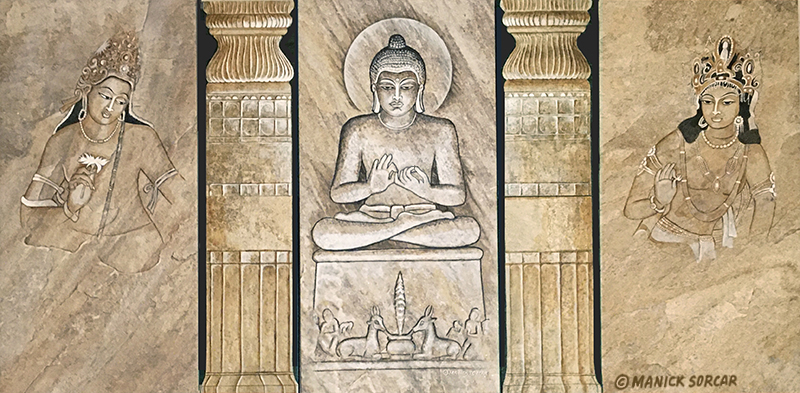
This grouped stone-tile artwork of mine is intended to depict 'Ajanta cave 1 trio' in brown tone to represent relative darkness of the cave, except for the shrine of Buddha sculpture slightly illuminated with an oil lamp (not shown). His sitting position is 'Padmasan' (Lotus pose) and hands are in 'Dharmachakra Mudra' (Teaching gesture). On left is
Padmapani, the bodhisattva of compassion,
and right, Vajrapani, the bodhisattva of protection, guide and power. Altogether,
this
special wall display is
50"W x 24"H,
including the columns.
.jpg)
This unique mural of Ajanta-theme Reclining Buddha is designed to be in the wall of a
Living room or a Family room.
The 5'-1"W x 2'-0"H artwork is painted on stone-tiles
that has the mechanism to be easily suspended/mounted on wall. It will be displayed at the art exhibition.
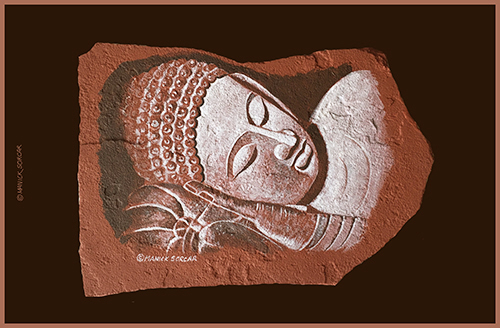
'Reclining Buddha': Here is a flagstone painting of the face of "Mahaparinirvana of Buddha" (Reclining Buddha) that will be displayed at the art exhibition. Inspiration for this art of mine came from the Reclining Buddha of Ajanta Cave 26, famous for its elaborate and intricate sculptures.
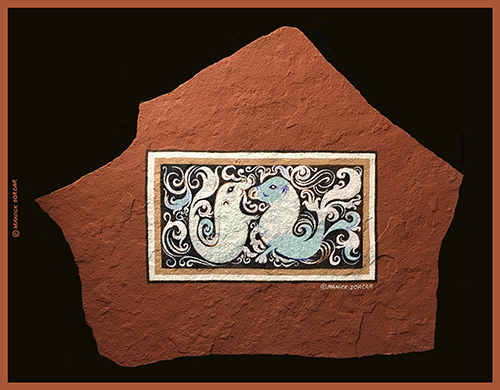
'Animals in Ajanta motif': The ceiling motif of Ajanta cave 1 has flora, fauna, figures and geometric designs. In many animals their bodies are transformed into swirling curvaceous lines blending into floral decorations such as this panel that I painted on a red flagstone.
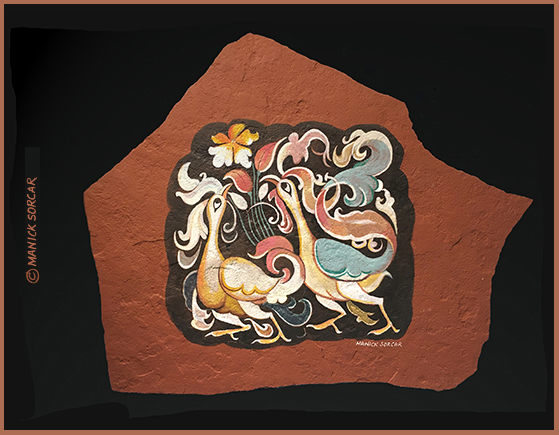
Animals in Ajanta Motif: Here is another flagstone art of mine based on an interesting panel at the ceiling of Cave 1, where two playful water birds of Anatidae family (Geese, Swans etc.) are within a flowery forest. Their wings and/or tails are transformed to blend into the floral
design of the background to show all living beings are only a part of Mother Nature.
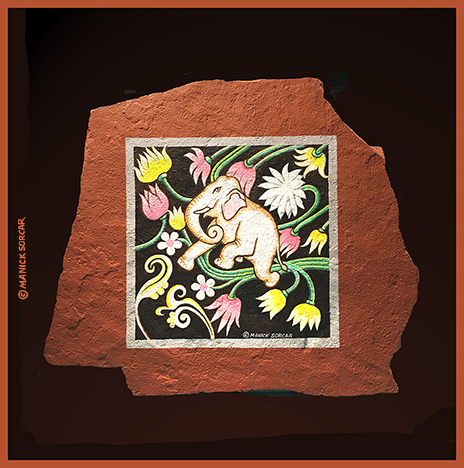
"Playful White Elephant" painted on a broken piece of red flagstone. Inspiration came from Ajanta cave1 ceiling motif
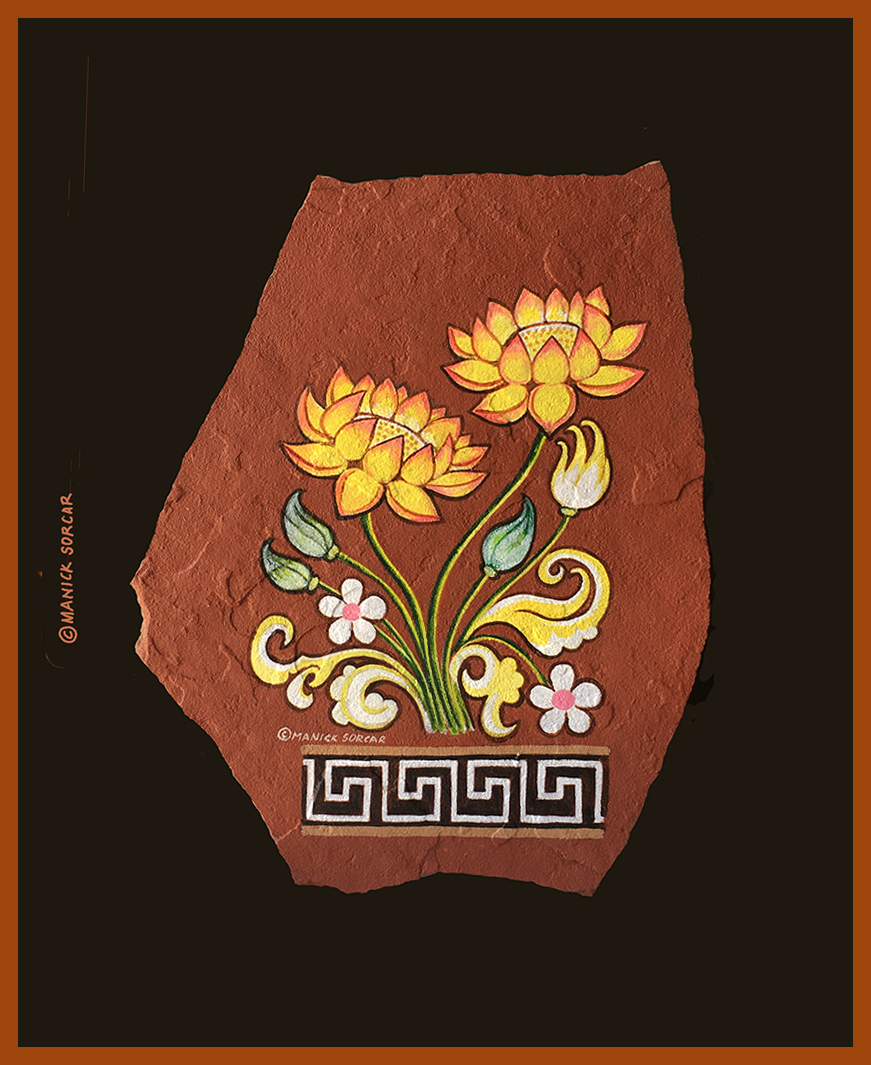
Ajanta floral motif painted on a broken piece of red flagstone
Needless to say I am in love with Ajanta. It is a classic example of Indian art, architecture, culture and religious beliefs integrated into a series of magnificent cave temples. Each time when I see an art from the cave, it fascinates me giving goose bumps - these are the oldest findings of Indian art and so beautiful! Questions intrigue me: what inspired them to hold the history in such a unique and magnificent manner? How did they manage to create such massive man-made caves chiseling through vertical rock surfaces with such finest architecture? Who were the artists, carvers and architects? What inhibited the work that started in 200BC, restarted 500 years later and stalled it again to be forgotten for 1300 years until re-discovered?
The rocks are the silent witnesses of all that, yearning to tell stories. Thank God, the site is a protected monument in the care of the Archeological Survey of India and since 1983, the Ajanta Caves have been a UNESCO World Heritage Site.
My first exhibition on Ajanta theme was held in September of 2018, as a part of the Arvada Art Studio Tour. I displayed a short, 10-minute laser show to introduce Ajanta to the American audience prior to visiting the exhibition. The effort was highly appreciated. Inspired by that I have decided to hold another, art exhibition on Ajanta in a grand scale come September, preceded by a full-length, half-hour laser documentary on the history and mystery of Ajanta caves. In the last exhibition, a great many of the artworks were promptly collected by admirers. Therefore, I have decided to spend the lockdown time in creating a variety of new arts starting from water paints on papers, acrylic on tiles, slates and flagstones to laser arts live-projected on walls to printed on a variety of canvases for the forthcoming exhibition. Painting on rock/stone tiles and on the rough surfaces of flagstones are of special thrill to me, as in an unexplainable way, they bring me closest to the cave arts. Ultimately, the goal is to take the earliest form of Indian art that initiated in 200 BC and present them in the state-of-the-art form of 21st Century utilizing traditional techniques to the cutting edge technology of laser.
(Note: For more images please visit the first part of this article)

Sculpture of 'Gautam Buddha in dharmachakra mudra' from Ajanta caves that
I painted on the rough surface of a large stone-tile

'The Lady on the Floor', painted on a rock-tile.
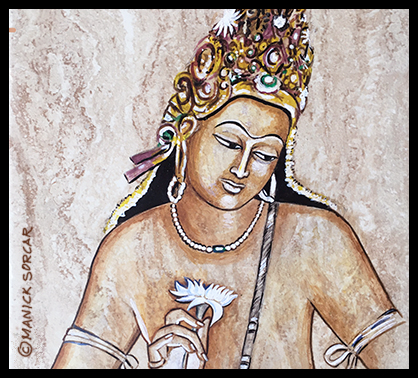
'Padmapani Bodhisattva' , painted on a rock-tile
Note: Because of ongoing COVID 19 Pandemic, the exhibition on "Ajanta Rocks: The Silent Witnesses", which includes a laser show, has been postponed indefinitely. We will keep you posted of any changes.

